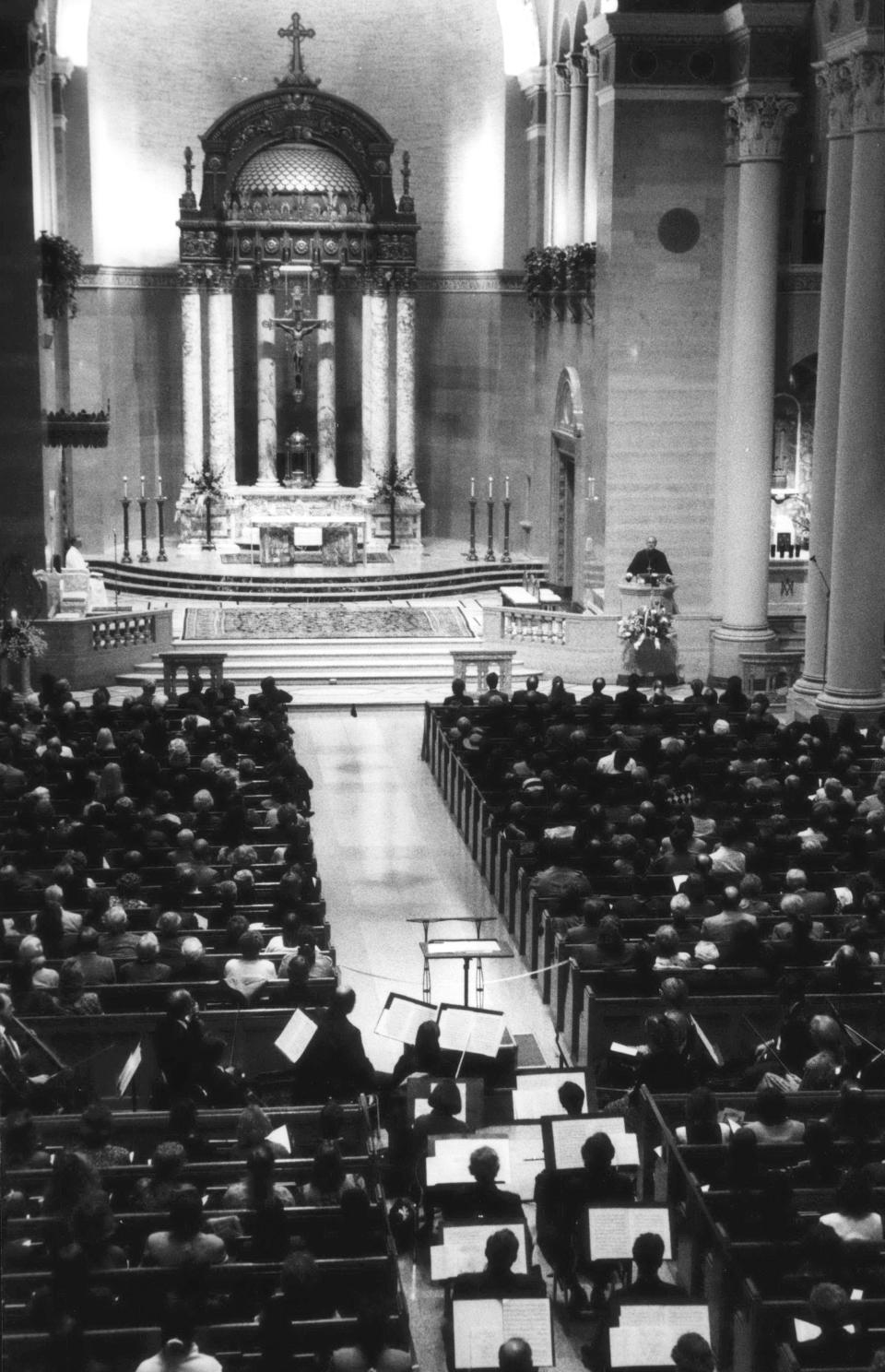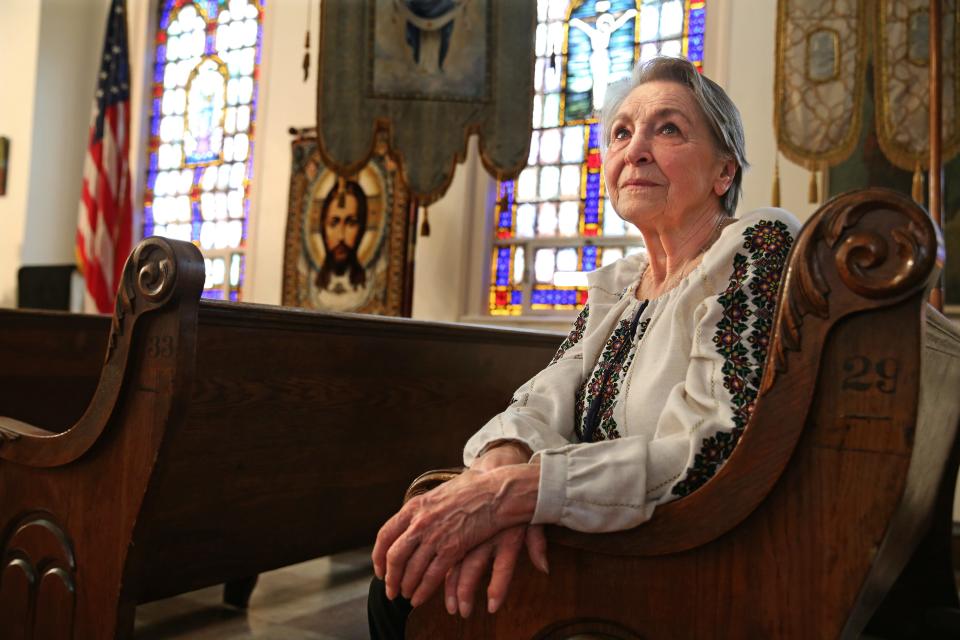These 10 historic churches are the oldest still standing in Milwaukee
As Milwaukee's early immigrant groups settled in the city throughout the early and mid-19th century, each brought unique customs and religious practices from their homelands.
Many groups eventually constructed churches, where they could engage in familiar cultural practices, build community and worship in their native languages. Although some now serve different religious communities than those of their founders, many of Milwaukee's earliest churches are still standing today, and you can visit them for religious services, history tours and other events.
Here are the 10 oldest churches still in use in the city of Milwaukee.
Old Saint Mary Parish is Milwaukee's oldest church still standing
Old Saint Mary Catholic Parish, at 844 North Broadway in downtown Milwaukee, was founded in 1846 ― two years before Wisconsin even became a state.
According to the parish website, Old Saint Mary was founded by early German Catholic immigrants to Milwaukee. Its first pastor, Fr. Michael Heiss, later became Milwaukee's second archbishop.
Old Saint Mary was designed by architect Victor Schulte, who went on to design St. John's Cathedral and other important buildings for the Archdiocese of Milwaukee. In 1848, King Ludwig I of Bavaria gifted a painting of the Annunciation to Old Saint Mary, which has hung above the church's high altar ever since.
The church was added to the National Register of Historic Places in 1973 and is the oldest church still standing and operating in Milwaukee. According to the parish website, mass is offered twice daily Monday through Friday, at 4:30 p.m. on Saturdays and three times on Sundays.

Saint John Cathedral has been the home of the Archdiocese of Milwaukee for over 150 years
Construction on the Cathedral of St. John the Evangelist, at 812 North Jackson Street, started on Dec. 5, 1847, when the cornerstone was laid.
According to the University of Wisconsin-Milwaukee's Encyclopedia of Milwaukee, the cathedral was made possible through the efforts of the first bishop of Milwaukee, John Martin Henni. When Henni came to Milwaukee in 1844, there was only one small church. So, he purchased land near that church on which to build the cathedral.
Schulte, the architect of Old Saint Mary, was also the cathedral's architect. However, the cathedral's tower was added in 1893 by Milwaukee architects George Ferry and Alfred Clas. The cathedral suffered a fire in January 1935. Practically only the tower could be saved from the fire, but St. John the Evangelist was rebuilt in time for Christmas Eve midnight mass in 1942.
Today, the cathedral is the seat of the Catholic Archdiocese of Milwaukee and is on the National Register of Historic Places. According to the cathedral's website, mass is offered at 5:15 p.m. Monday through Saturday and three times on Sundays. Visitors can also tour the cathedral by contacting the parish office at 414-276-9814.
First home to German immigrants, Holy Trinity Catholic Church later became a source of community for Milwaukee Latinos
Holy Trinity Roman Catholic Church, 605 South 4th Street, is Milwaukee's third-oldest standing church and the first Catholic church on the city's south side. According to Wisconsin Historical Society records, construction on the church was completed in 1849 or 1850.
Like Old Saint Mary and the Saint John Cathedral, Holy Trinity was designed by Schulte. It was settled by Catholic immigrants from southern Germany and Austria who lived in Milwaukee's Walker's Point neighborhood. However, as the demographics of Walker's Point changed over the decades, so did the make-up of Holy Trinity's congregation.
According to the church's 1972 National Register of Historic Places nomination form, Holy Trinity evolved into a largely Spanish-speaking congregation and became home to many Mexican and Puerto Rican Americans by the 1960s. Around that time, Holy Trinity merged with Our Lady of Guadalupe Church and became also known as Holy Trinity-Our Lady of Guadalupe Roman Catholic Church.
Research by Milwaukee architectural historian Andrew Hope for his Architecture of Faith project found that, by the 1970s, 90% of the church's parishioners were Latino. The church is now known as Our Lady of Guadalupe and celebrates mass regularly in both English and Spanish.

Built for Norwegian Lutherans in 1859, Saint Mary's Ukrainian Orthodox has served Milwaukee's Ukrainian community for over a century
Saint Mary's Ukrainian Orthodox Church of Milwaukee, at 1231 West Scott Street, is a modest, wood-framed building, but it has stood on the city's south side since 1859.
According to the church website, the building was first home to members of the Norwegian Evangelical Lutheran Church, who constructed it on West Lapham Street between South 7th and South 8th Streets. Since then, the building has been moved twice and has served four congregations.
Milwaukee's first Ukrainian immigrants began settling in the Walker's Point neighborhood in the early 20th century, according to UWM's Encyclopedia of Milwaukee.
In 1917, as the number of Ukrainian immigrants continued to rise due to World War I and the Russian Revolution, a group of Ukrainian Orthodox Church members purchased the church building and established Saint Mary's. In its early years, Ukrainian immigrants of various religious and cultural backgrounds gathered at the church to worship, socialize and preserve their language and customs.
More than a century later, Saint Mary's continues to serve Milwaukee's Ukrainian-American community, including by holding services in the Ukrainian language. According to the Milwaukee Journal Sentinel, the church has about 30 current members; most are older, and "nearly all" have siblings, children, parents or other close family members still living in Ukraine.
West Granville Presbyterian Church celebrated its 160th anniversary in 2020
West Granville Presbyterian Church, at 6935 North 107th Street, was founded in April 1860 by 26 German Calvinists, the church website states.
The church, originally known as "Die erste Presbyterian Kirche," was built with Cream City brick and, at first, only conducted services in German. During the church's early years, the congregation provided assistance to newly freed former slaves through the Freedman's Board.
In 1913, English was adopted as the sole language of the church and its Sunday school programs. According to the church website, the small congregation often had to share a minister with another church or, at times, had no minister at all. In 1946, the congregation had 94 members.
West Granville has long been committed to welcoming, supporting and sponsoring immigrants, civil rights, and serving nearby neighborhoods and communities. Today, the church remains active, holding Sunday services and operating a licensed nursery school. West Granville celebrated its 160th anniversary with a luncheon in February 2020.
Salem Evangelical Lutheran started out in a log cabin and grew into a storied church and school community
The modern-day congregation at Salem Evangelical Lutheran Church, at North 107th Street, can trace its roots back to 1847, when German immigrant families began gathering for services in a log cabin near where the Salem Church stands today.
The brick Salem Church was built in 1863 to accommodate the growing congregation and became known as the "Landmark Church," according to the church's website. Although the church is in present-day Milwaukee, at the time of its construction it was considered to be in Granville Township, nearly seven miles outside of the-then city limits. A Lutheran grade school began operating in the church basement in the late 1800s and moved to its own building in the 1950s.
According to the church website, in the 1970s, plans for a new church building and classroom additions were realized. The new church was completed in 1977, but the Landmark Church still stands and hosts scheduled tours. The new church and school continue to operate today.
Saint James Episcopal Church found new life as a wedding and event venue
English architect Gordon Lloyd, the designer of many Episcopal churches throughout the country, designed Saint James Episcopal Church, 833 West Wisconsin Avenue. The church was completed in 1867 or 1868.
Hope reported in Architecture of Faith that Saint James is the oldest stone church and the oldest church in the Gothic Revival architectural style still standing in Milwaukee. The church's exterior was built using Wauwatosa limestone.
Only a few years after the church's completion, on New Year's Eve 1872, a fire destroyed all but the church's perimeter walls, its tower and steeple, and some windows, Hope wrote. It was rebuilt using Lloyd's original plans, and services were held again beginning in April 1874. Numerous stained-glass windows were installed in the church from the 1870s through the 1950s, including two Tiffany windows.
After decades of declining membership, Saint James was purchased by a developer whose 2018 plan to turn the church into an apartment building fell through. The church was then purchased by former Kohl's Corp. manager Katie Crowle's investment group in July 2018.
Crowle's team renovated the church, transforming it into St. James 1868, a wedding and events venue.
All Saints' Cathedral was the first planned cathedral of the Episcopal Church in the United States
All Saints' Cathedral, at 818 East Juneau Avenue, was constructed as Olivet Congregational Church and completed in 1869.
According to Hope, the building only served as a Congregational church for a few years before "dissention within the congregation" led to many members leaving for other nearby churches. In 1873, Olivet was purchased by the Episcopal Diocese of Wisconsin. Before acquiring the cathedral, the Episcopal diocese had a modest wooden chapel on Jackson Street and had been advocating for a larger worship space since the 1860s.
According to the cathedral website, All Saints' Cathedral became the first "canonically correct" Episcopal cathedral on American soil. It is currently the bishop's church of the Episcopal Diocese of Milwaukee.
The cathedral was added to the National Register of Historic Places in 1974. It remains active today with Sunday services and spiritual formation, music and charitable events.
Calvary Presbyterian, Milwaukee's "Big Red Church," was built in 1870
Calvary Presbyterian Church, at 935 West Wisconsin Avenue, is known for its unique exterior ― Cream City brick painted a deep red. The church's official website is even www.bigred.church.
According to Hope, before Calvary, there were only two Presbyterian churches in Milwaukee, and both were on the east side of the Milwaukee River. Calvary was formed by members of the two churches who lived on the west side and wanted a church closer to home.
Calvary was designed by the Milwaukee architectural firm Koch and Hess. Architect Henry Koch went on to design Milwaukee City Hall, along with numerous churches and other buildings.
Calvary remains an active Presbyterian church to this day, with worship services every Sunday at 10:30 a.m. According to the church website, you can schedule a visit to the historic building by filling out an online request form. You can also schedule a time to walk the church's indoor labyrinth, a circular prayer and meditation path designed in the medieval tradition.
Milwaukee's Polish community found a home at Saint Stanislaus Catholic Church in 1872
Saint Stanislaus Catholic Church, 1681 South 5th St., was the city's first church dedicated to its Polish Catholic community.
The church website states that, in 1866, thirty Polish Catholic families came together to buy a small brick church, which they dedicated to Saint Stanislaus, the patron saint of Poland. As Milwaukee's Polish population continued to grow, the congregation realized its need for a larger worship space, and the cornerstone of the current church was laid in 1872. A year later, the Cream City brick church with twin spires was complete. According to the church website, in 1873, Saint Stanislaus also established America's first Polish parochial school.
Throughout the years, the church has undergone numerous renovations.
Today, Saint Stanislaus offers mass at least once per day, including traditional Latin High Mass on Sunday. The tradition-minded church also offers a number of faith formation groups, including a choir, Catholic boy scouting, and young adult and Catholic moms groups.
More: Here's a look at seven 19th-century church buildings in the Milwaukee suburbs
This article originally appeared on Milwaukee Journal Sentinel: Oldest churches in Milwaukee date back to 19th century

